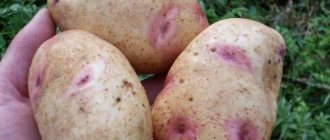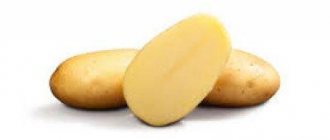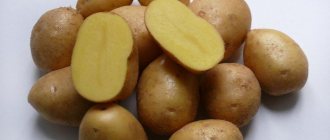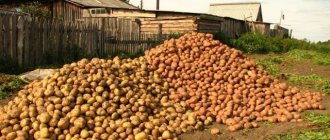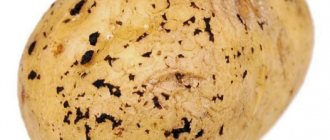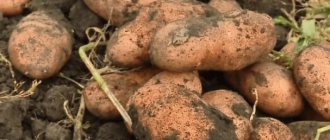Spreading
The Felox subspecies was bred by German breeders. The originator is Saka Palanzenzucht.
In Russia, the distribution of the subspecies is carried out by the Oktyabrsky enterprise and the Sedek farm.
Today the variety has become widespread throughout the world..
It is grown in Germany, Austria, Holland, India, and China. It also actively grows in Belarus, Moldova, Kazakhstan, Ukraine, and the Russian Federation.
In Russia, potato bushes of this variety can be found in almost all regions. The subspecies grows well in any weather conditions. Tolerates drought and sudden temperature changes.
Important! This variety is recommended for early planting and early harvesting.
Breeding a variety
The Felox variety was produced in Germany by employees of the company Saka Palanzenzucht. Today it is grown almost all over the world - in Europe, America, Asia, India, China, and in the countries of the former Union. This is possible due to the fact that the crop adapts well to any climate, soil, and withstands cold, temperature fluctuations and dry periods. The variety is included in the State Register of the Russian Federation with a recommendation for cultivation in the Middle Volga region.
Did you know? The largest tuber in the world, weighing 11.2 kg, was grown by Lebanese farmer Khalil Semhat. He ended up on the pages of the Guinness Book of Records.
Potato Felox variety characteristics
| Variety name | Felox |
| general characteristics | high-yielding variety of German selection |
| Maturation period | 60-70 days |
| Starch content | 16-17% |
| Weight of marketable tubers | 100-120 gr |
| Number of tubers in a bush | 19-25 pieces |
| Productivity | 550-600 c/ha |
| Consumer qualities | excellent taste, suitable for preparing any dish |
| Keeping quality | 90% |
| Peel color | yellow |
| Flesh color | light yellow |
| Preferred Growing Regions | Northern, Northwestern, Volga-Vyatka, Middle Volga |
| Disease resistance | resistant to potato canker pathogen, golden cyst nematode, moderately resistant to late blight |
| Features of cultivation | adapts to any type of soil |
| Originator | Saka Palanzenzucht (Germany) |
The bushes are an erect, leafy variety. The leaves are large or medium. They have a dark emerald hue. The edges of the leaves are slightly jagged.
The surface of the leaves is glossy. The corolla is large. It has a burgundy-lilac color. The anthocyanin tint of the bud is very weak. The tuber is elongated and has a rounded shape at the edges.
Weight varies between 100-120 g. The largest specimens weigh 200 grams. The peel has a soft amber hue. The pulp is light, snow-white-amber. The starch content reaches 16-17%.
You can compare tuber weight and starch content with other varieties using the table below:
| Variety name | Starch content (%) | Mass of tubers (g) |
| Artemis | 11-15 | 110-120 |
| Tuscany | 12-14 | 90-125 |
| Openwork | 14-16 | 95-115 |
| Santana | 13-17 | 100-170 |
| Nevsky | 10-12 | 90-130 |
| Ramos | 13-16 | 100-150 |
| Lapot | 13-16 | 100-160 |
| Belmondo | 14-16 | 100-125 |
Important! Experienced gardeners recommend spraying the tubers with copper sulfate before planting. With the help of growth stimulants, the bushes grow more lush, and the formation of tubers occurs at a rapid pace.
Potatoes store well, the main thing is to remember the necessary conditions and terms. We have prepared for you detailed information on storing potatoes in boxes, in winter, in the refrigerator and peeled.
Peculiarities
Characteristics:
- Belongs to early ripening varieties. The growing season ranges from 65 to 70 days;
- Productivity reaches 250 centners per hectare. Maximum yield - 600 centners per hectare;
- Immune to adverse weather conditions: resistant to drought, sudden temperature fluctuations;
- Suitable for transportation over long distances.
REFERENCE: Pre-planting spraying of planting material with copper sulfate is recommended. Thanks to growth stimulants, the bushes grow more luxuriantly, and tubers form quickly.
Photo
The photo shows the Felox potato variety:
Technology for growing varieties in open ground
The highest yields can be achieved from potatoes that are planted in a suitable place, after the recommended predecessors, at the required time, with proper preparation of the soil and planting material.
This subspecies grows best in soft, loose soil. In stone soil during the growing season, the growth of bushes can slow down greatly. In this case, the tubers are greatly deformed
Optimal landing location and timing
When growing in open beds, potatoes should be allocated a place that is sufficiently illuminated by the sun. According to the rules of crop rotation, seeds should be placed in the soil where green manure, cucumbers, legumes, onions, cabbage, carrots, and beets previously grew. Planting in beds previously occupied by potatoes, tomatoes, and peppers is not recommended. When to plant, it is necessary to determine the temperature of the soil - at a depth of 10 cm it should warm up to +8...+10°C.
You will be interested to know what is better to plant after potatoes.
Depending on the growing region, this may occur from late March to early May. When planting early, the beds should be covered with film or non-woven material. There is another way to determine the most successful time for planting potatoes - folk signs. According to experienced gardeners, a clear sign that seeds should be buried in the ground is the opening of buds on birch trees and flowers on bird cherry trees.
Soil type
Any type of soil for Felox potatoes is suitable. Important conditions for successful potato growing are:
- the occurrence of groundwater at a level no closer than 65–70 cm from the soil surface;
- neutral or slightly alkaline pH reaction.
Important! Reducing acidity is helped by adding lime, dolomite flour, wood ash, and crushed eggshells to the soil.
The successful growth and development of a crop largely depends on how well the area is prepared for planting. Preparation is carried out in the fall or spring. In the autumn, it is necessary to remove plant debris from it, dig it deeply (20–25 cm deep) and fertilize it using urea, manure, and wood ash. If it was not possible to apply fertilizer in the fall, then the beds are fertilized in the spring.
In 2–3 weeks, you need to prepare the holes for planting and add 1 liter of dry humus, 1 handful of wood ash, 1 tbsp. l. nitrophoska, 1 tbsp. l. ammophoska, 0.5 tbsp. dolomite flour. Another fertilizing option is also possible: 2–3 handfuls of humus (rotted compost), 1 tbsp. l. wood ash, a small amount of chicken droppings, 3-4 tbsp. l. onion peel. During this period, fresh manure should not be introduced. It is capable of burning seeds.
We recommend that you familiarize yourself with the specifics of applying fertilizers for potatoes when planting.
Preparation of planting material
Potato seeds need to be germinated before planting. To do this, in about a month they are moved from the storage location to a room well illuminated by diffused light with a temperature of +13...+16°C and a humidity of 90–95%. Then culling is carried out, removing large and small tubers, damaged, diseased, without sprouts. For seeds suitable for planting, the sprouts should reach a length of 1 cm. 3 days before planting, the selected tubers should be placed in an aqueous solution of wood ash, Prestige or Epin-Extra preparations.
Thanks to growth stimulants, the bushes grow more luxuriantly, and tubers form quickly. This is necessary in order to prevent infection of plants by certain diseases and damage by harmful insects. To make the seeds sprout faster, they are placed in “Kornevin” or “Heteroauxin”. You can shorten the germination process to 20 days by placing the seeds in moistened sawdust or peat, pre-treated with a solution of copper sulfate (2 g/1 l of water). Seeds can also be placed in glass containers with a volume of 3 liters, which are then placed on a bright and warm windowsill.
Important! When planting Felox potatoes in regions where frosts are observed for a long time, rotted herbal plants are placed at the bottom of the holes. This way you can protect the seeds from freezing
Planting methods and scheme
Holes for planting are dug at a distance of 35–40 cm from each other. The row spacing should be 70–80 cm. How deep to dig the holes depends on the type of soil. In light and loose soils, the recommended hole depth is 6–7 cm. If the soil is heavier, then the seeds should be deepened by 7–8 cm. In very heavy, clayey soils, the holes should go 8–9 cm deep.
The technology for planting potatoes is as follows:
- Place 1–2 seeds in one hole.
- Fill the hole to the brim with soil.
- Loosen the beds.
- Cover the plantings with film (if required).
Productivity
Felox is an early ripening variety. From planting to technical ripeness, 65-70 days pass. The harvest ends at the end of August. The productivity of the variety is very high .
250 centners of potatoes are harvested from 1 hectare. The maximum yield is 600 c. One bush forms 19-25 tubers. The fruits are resistant to damage. They keep in cool vegetable stores for about six months.
In the table below you can see what the yield is and how many tubers there are in a bush for other potato varieties:
| Variety name | Productivity (c/ha) | Number of tubers in a bush (pcs) |
| Belmondo | 450-800 | 7-9 |
| Gourmet | 350-400 | 12-14 |
| Palm | up to 450 | 5-9 |
| Blue Danube | 350-400 | 8-12 |
| Lily | up to 670 | 8-15 |
| Tiras | 210-460 | 9-12 |
| Colombo | 220-420 | up to 12 |
| Santa | up to 570 | up to 20 |
They have excellent commercial qualities . Marketability reaches 98%. The variety is in great demand. Sold in markets and stores. Felox potato variety can be transported over long distances .
The main advantages and disadvantages of the variety
The variety has many advantages:
- early ripening;
- grows on any soil;
- does not require special growing conditions;
- optimal starch content in tubers;
- high yield rates;
- excellent taste;
- preservation of presentation during long-term transportation;
- long shelf life.
The disadvantage is the need for additional treatments against late blight, wireworm, and scab.
Landing
The agricultural technology of this variety is standard. Planting takes place in early May . It is recommended to plant tubers after perennial grasses, peas, beans, corn, and beans. Recommended planting pattern: 30x65 cm. Depth should not exceed 8 cm.
If you plant Felox seed potatoes too deep, they may rot in the ground. Before planting, water the soil thoroughly.
The soil should be slightly acidic. Suitable sandy, loamy, turf soil. But it is best to use black soil.
Before planting, check for any defects or infestations . It is not recommended to plant defective tubers. The optimal weight of planting material should be 60-80 g.
Important! This subspecies grows best in soft, loose soil. In stone soil during the growing season, the growth of bushes can slow down greatly. In this case, the tubers are greatly deformed.
There are many ways to grow potatoes. On our website you can get acquainted with Dutch technologies, as well as methods of growing potatoes in bags, in barrels, under straw.
Harvest and storage
The readiness of fruits for harvesting is determined by the condition of the lower leaves. If they turn yellow, it means you can make the first dig. Full harvesting must be done when the tops turn yellow to the top. If we talk about calendar dates, then, as a rule, Felox fruits ripen at the end of August. The tubers are dug up with a shovel or pitchfork and then cleared of soil. For the first 7–14 days after harvesting, potatoes are stored in bags in a room with no sunlight and good ventilation.
We advise you to find out when is the best time to dig potatoes for storage.
The optimal storage temperature is +15…+20°C. After this, tubers unsuitable for storage are removed - diseased, damaged, rotten, or stained. The best specimens are placed in storage with a temperature of +3...+5°C, humidity at 90–95% and good air circulation. If stored properly, tubers of this variety can be stored for up to 6 months.
To summarize the above, we note that the Felox variety is classified as medium-early and high-yielding. It has a number of advantages, which include good adaptation to external conditions, tasty fruits, and ease of care. All this gives reason to recommend it for growing in the garden.
Diseases and pests
The subspecies is highly resistant to cancer, golden cyst nematode (Ro1,4). Moderately resistant to late blight of tubers and leaves.
Often, nightshade plants, including potatoes, are threatened by diseases such as Alternaria, Fusarium, Verticillium, and scab. Read more about them in the articles on our website.
Subject to attacks by wireworms.
Click beetles are also noted among the pests. They have an elongated body and settle on the stems and leaves of the plant. Causes irreparable damage to agricultural land.
This subspecies of potato requires preventive measures against pests, for example, against the Colorado potato beetle. Read in the articles on our website what folk remedies and chemical preparations exist to combat adults and larvae.
Insecticides are used as prevention. You can use granular products that are applied once. The “Prestige” product is perfect.
Potato Felox is an early ripening variety. Has a table purpose. Can be transported over long distances .
Resistant to mechanical damage. It has excellent commercial qualities. Grows well in any weather conditions. Loves slightly acidic soil, systematic watering, and fertilization. Read about when and how to apply fertilizers and how to do it correctly when planting in the detailed materials on our website. And mulching will help in the fight against weeds.
Growing and care
Potatoes are watered during periods of drought. Moisturizing is especially important during the growth of tops - one to two weeks after germination, as well as during the formation of tubers and at the beginning of budding.
Fertilizing is applied 2-3 times per season. Solutions must be weak, otherwise nitrates may be deposited in the tubers. It is prohibited to use fresh manure.
The first fertilizing is applied during the period of growing tops. It should consist of a weak solution of chicken droppings or humus or mineral nitrogen fertilizer. The second feeding is at the beginning of budding. Potassium-phosphorus fertilizers are used.
Fertilizing should only be applied to moist soil after watering or rain. When added to dry soil there is a risk of burning the roots.
Periodically loosen the soil and hill up the bushes. It is necessary to carry out two hillings before flowering begins.
Characteristics and description
Read shelf life, temperature and any problems that may arise. And also about storage in winter, on the balcony, in the refrigerator, in boxes, cleaned.
| Variety name | Weight of marketable tubers (grams) | Keeping quality |
| Vega | 90-120 | 99% |
| Lady Claire | 85-110 | 95% |
| Innovator | 100-150 | 95% |
| Labella | 180-350 | 98% |
| Bellarosa | 120-200 | 95% |
| Riviera | 100-180 | 94% |
| Gala | 100-140 | 85-90% |
| Lorch | 90-120 | 96% |
| Limonka | 75-150 | 90% |
The great advantage of the variety is its high yield. When grown on fertile soils, up to 500 centners of selected potatoes can be harvested from 1 hectare. The average yield is from 230 to 380 centners per hectare.
| Variety name | Productivity |
| Vega | 230-380 c/ha |
| Tuscany | 210-460 c/ha |
| Rocco | 350-600 c/ha |
| Nikulinsky | 170-410 c/ha |
| Red Lady | 160-340 c/ha |
| Uladar | 350-700 c/ha |
| Queen Anne | 100-500 c/ha |
| Elmundo | 245-510 c/ha |
| Asterix | 130-270 c/ha |
| Slav | 180-330 c/ha |
| Picasso | 200-500 c/ha |
Medium-sized bushes, erect or semi-erect, intermediate type. The foliage is average. The leaves are simple or intermediate, dark green, with slightly wavy or medium wavy edges. Berries are few. Large white or cream flowers are collected in compact corollas. The sprouts are white, slightly pubescent.
Vega potatoes are undemanding to growing conditions. It tolerates minor errors in agricultural technology and tolerates light frosts, heat or drought. Productivity increases significantly with timely fertilizing. Read about what to feed potatoes, when and how to apply fertilizers, how to do it correctly when replanting.
Frequent hilling, weed removal and mulching are required.
The variety loves moisture very much, but does not tolerate stagnation of water in the soil. To increase productivity, frequent watering during the flowering period is recommended, after which the amount of moisture can be reduced.
The tubers have a pleasant, rich taste, without being watery or excessively dry. The average starch content makes root vegetables versatile; they are suitable for deep-frying, seasoning soups, preparing side dishes, vegetable chips, stuffing, and baking. The tubers do not boil over and retain their shape. Not suitable for making purees.
Yellow pulp indicates a high carotene content, which makes it possible to recommend potatoes for baby and dietary nutrition. During cutting and cooking, root vegetables do not darken, maintaining a beautiful golden color. Potatoes are suitable for preparing semi-finished products: frozen slices, chips, vegetable mixtures.
- medium-sized erect or semi-erect bushes, type - intermediate;
- medium degree of foliage;
- dark green wavy foliage;
- large flowers that are painted in white or cream tones and collected in compact corollas;
- white slightly pubescent sprouts;
- medium-sized tubers;
- oval or round-oval fruit shape;
- yellow colored peel;
- small, few, not deep-set eyes;
- dark yellow pulp;
- approximate tuber weight 90–120 g;
- absence of non-commodity items4
- the number of tubers in the bush, which ranges from 8–10 pieces;
- the duration of the ripening period is from 50 to 60 days.
Vega potatoes are an early variety that is always popular among many gardeners. This varietal variety of potatoes is grown both for personal use and for sale. The advantage of this nightshade crop is its versatility in cultivation. Thanks to compliance with all the rules of agricultural technology, even novice vegetable growers can grow Vega potatoes.
Description of the variety
The Vega potato variety produces a high yield; on average, from seven to nine large-sized potatoes are harvested from one bush. The tuber is medium in size, round-oval in shape, weighs from 85 to 100 g.
Vega is distinguished by its small bush size, the stems are erect, sometimes semi-erect. The leaves are simple in shape with a dark green tint, the edges are slightly wavy. The bush is characterized by an average degree of foliage. The flowers are collected in corollas, are large in size, and are white-cream in color.
Protecting grain from birds
Birds cause damage to grain farming.
A flock of birds eats a lot of grain and its processed products, feeding almost all day. Pigeons and sparrows, having free access to warehouses, can destroy large amounts of grain in a day. One pigeon eats about 50 g of the grain mixture, a sparrow about 25 g. In addition, birds pollute grain mounds with excrement, which is practically impossible to clean. Birds can also become carriers of grain pests. As they fly from warehouse to warehouse, they carry ticks. Read more
14.07.2020
